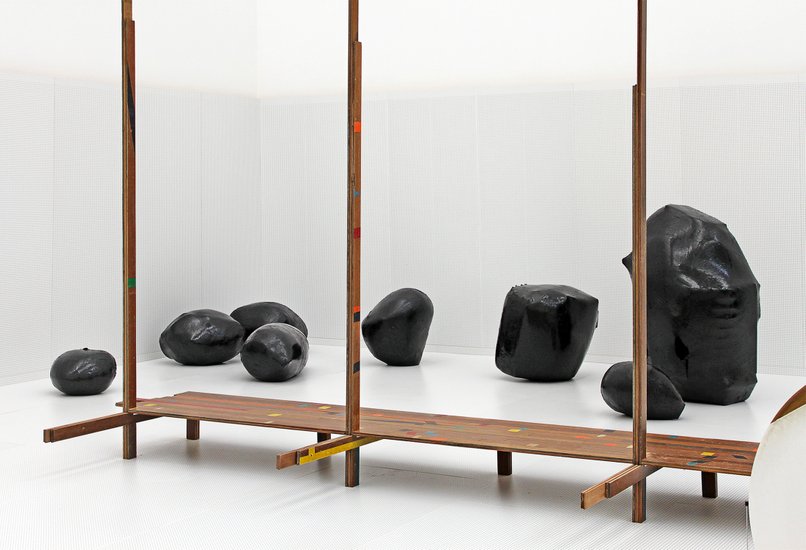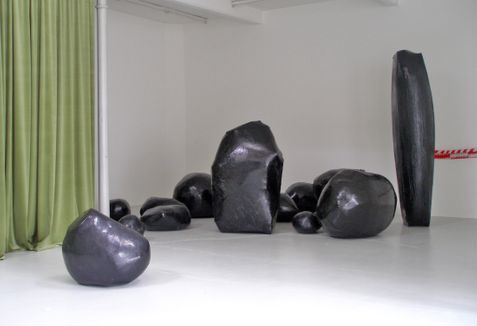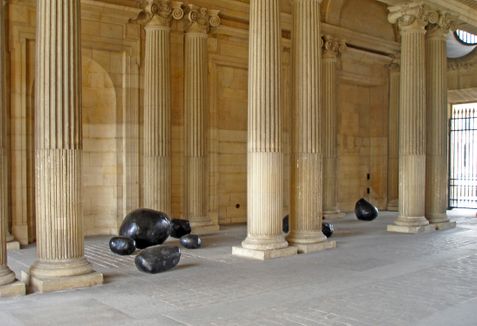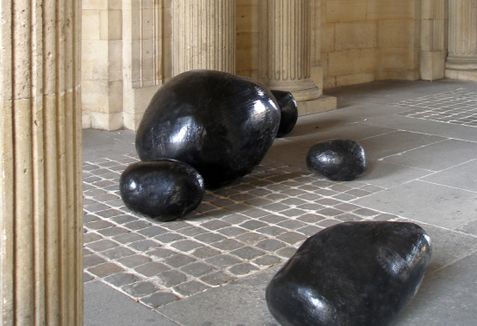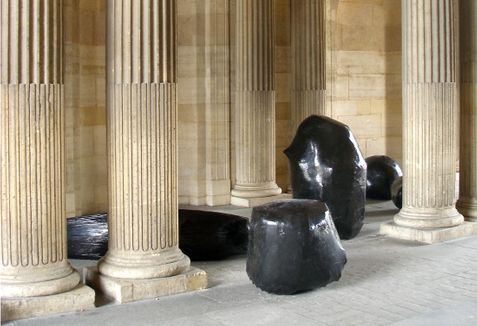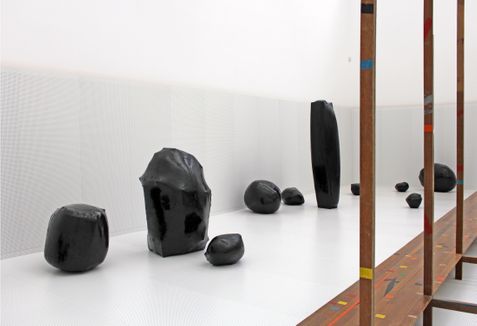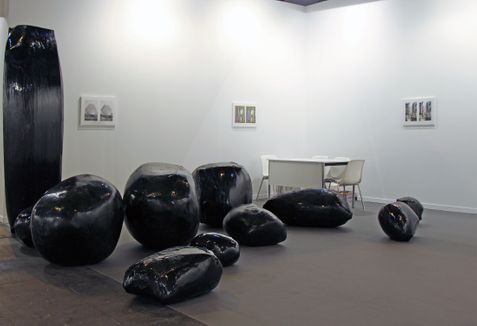Suchan Kinoshita
Isofollies, 2007-2017
Mixed media (wrape, plastic, oil), variable dimensions
Suchan Kinoshita’s Isofollies (2007) is an installation composed of fourteen strange meteorites or asteroids, their composition unknown. Bulbous masses, varied and singular volumes, these megaliths act like monumental scoria: they are petrified bundles. A first series of these sculptures appeared in 2006. In the exhibition space itself, in the basement and the attic of the gallery where she was showing, the artist gathered, serialized, and bundled up all manner of objects – waste, in fact, those things that over time had been abandoned, had stopped being useful. With these, she composed bundles of varying sizes; she mummified the scrap, literally and figuratively, by packing it using long strips of industrial plastic, elastic and black, and then rolling the resulting bundles on the floor, compressing them and thus compacting the fossilized waste. What is petrified here is the time of the place, its history. The eleven aeroliths that compose the work were distributed in the exhibition space like a constellation. In 2007, during a solo show at the Ikon Gallery in Birmingham, three new aeroliths appeared, and from that moment on the work took on the name Isofollies, after the plastic wrap used to make it. At the Ikon Gallery, she used the residues from the installation process of her show. The first ensemble of these sculptures thus became a delocalized principle.
Suchan Kinoshita was invited to the 8th Sharjah Biennial, in the United Arab Emirates, in April 2007. With its unbridled consumerism, its artificial islands, its ostentatious luxury towers, its ‘green’ desalination plants and its suburbs carved onto the desert sands, the United Arab Emirates are a nightmare for environmentalists. And that was precisely the problem that the artistic directors of the Biennial decided to address: Still Life, Art, Ecology and Political Change is inscribed in an urgent and ongoing research process whose goal is to highlight the renewed role that art can play in the resolution of a large panoply of questions that have a direct, and alarming, effect on life as we know it. It was about addressing the social, political and environmental challenges raised by excessive development and the ever-increasing depletion of natural resources. Naturally, against this background, Suchan Kinoshita decided to the produce a third set of her Isofollies. This new constellation was, like the other ones, produced in-situ, with waste and scraps found on the spot. Born in a domestic context, the compressed time of a place, a recycling of the lived experience of its successive inhabitants, at the Sharjah Biennial the very principle of the work took on a heightened, and in some ways planetary, meaning.
These successive constellations act like a space of thought with a variable geometry, from the singular to the more universal: Suchan Kinoshita buried the waste of a household, then the residues produced by the mounting of an exhibition, and lastly the condensed extracts of the waste of a megalopolis. In a fourth version of the work, from 2014, she buried the personal objects and souvenirs of a person who had died, traces of memories that in her work found a new vitality, at once abstract and universal. Nothing in Suchan Kinoshita’s work is ever fixed. Her shift-shaping work is always in progress, always being transformed in light of accumulated experiences. The artist always treats every exhibition like a fragment of a whole whose limits, and ends, are outside of her control. The works are linked by the will of the artist, but they are also enriched by unforeseen connotations and can be read differently depending on their context. It is interesting, in this regard, to consider the various moments and places where the constellation conceived for the Sharjah Biennial has reappeared. In this exhibition devoted to the ‘career of the spectator’ (2009), certainly a full-time job, the fourteen elements of the Isofollies were placed in counterpoint to a monumental green velvet curtain upon which a spotlight projected the luminous halo of a projector and behind which a disco ball turned slowly on its axis. In this relation between the telluric and the aerial, the installation evokes a conjunction of elements that refer to the universe of René Magritte and his mysteries. Placed under the archways of the Pavillon de l’Horloge, the eastern entrance to the Cour Carrée of the Louvre in Paris, the Isofollies operated like a mineral chaos amidst the classical layout of the fluting columns erected by the architect Jacques Lemercier in the seventeenth century. For her exhibition In Ten Minuten (time is an essential parameter of this artist’s work), at the Ludwig Museum in Cologne (2010), she placed the Isofollies in relation to another work, Engawa, a pontoon made of meranti wood cut into thin parquet slats, and dotted here and there by coloured lines and small yellow, blue and red squares, and punctuated by the stilts that support the structure, but that overshoot it in places. In traditional Japanese architecture, the engawa is a raised wooden walkway that surrounds the house, almost like a porch. It’s a passageway, covered by a slanted roof. The engawa mediates the relation between inside and outside. It’s a place to stand, to sit down and contemplate the garden or landscape, to meditate. In this case, a place to face the field of aeroliths so reminiscent of the total sparseness of the Japanese garden. The Sakuteiki, the oldest Japanese book about gardening, opens with the title ‘The Art of Setting Stones’. In 2011, for her show The Right Moment at the Wrong Place, at the Museum De Paviljoens, in Almere, the Netherlands, she concentrated the Isofollies into a narrow and dark enclave, a return to the obscure chaos of its origins. Finally, during the exhibition Tussenbeelden at the Schunck* (Heerlen, 2014), curator Paul Van der Eerden compared the Isofollies to the Bolis – reliquary manifestations of the vital force whose primary function is to accumulate and control the force of natural life of the Bambara people in West Africa. The Bolis contain a variety of elements, their surface is constantly impregnated by layers and layers of libations. For the initiated, the Boli is a presence that transcends the object itself; a real object in a real space, it occupies also a mental space in the memory of the community. (Jean-Michel Botquin)

